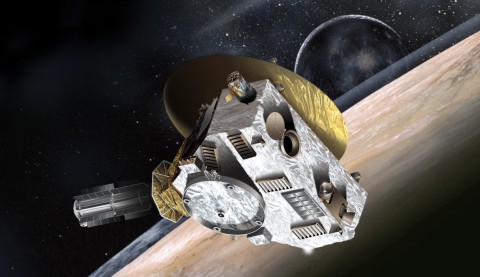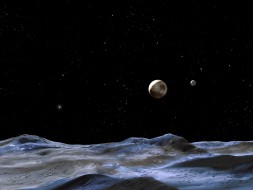New Horizons will reach Pluto a year from today, and the scientific community is abuzz with speculation about what the space probe might see when it gets there. Meanwhile, the New Horizons team scours the skies for a Kuiper Belt Object that New Horizons can visit after its Pluto flyby.

Johns Hopkins University Applied Physics Laboratory/Southwest Research Institute (JHUAPL/SwRI)
After hurtling through the solar system for nearly a decade, the New Horizons space probe will finally reach Pluto a year from today, promising exciting new insights about the object formerly known as the ninth planet.
Since its discovery in 1930, Pluto has largely remained shrouded in mystery. Even the Hubble Space Telescope can only discern features larger than a few hundred kilometers on Pluto’s surface (Pluto itself is less than 2,400 kilometers across). From sub-surface oceans to collapsing atmospheres, Pluto is a veritable wellspring of unresolved questions, but scientists anticipate that New Horizons will provide some long-awaited answers.
Speculation and Anticipation
Cathy Olkin (Southwest Research Institute) and colleagues have suggested that Pluto retains its atmosphere year-round. Astronomers previously predicted that as Pluto’s highly elliptical (oval-shaped) orbit carried it away from the sun, the gas in its thin nitrogen atmosphere would freeze and fall to the surface. When Pluto occulted (moved in front of) a background star on May 4, 2013, Olkin’s team studied the effects on starlight passing through Pluto’s atmosphere and fit this data to an atmospheric model developed in 1992. They concluded that their observations could only be explained if Pluto’s atmosphere never collapses.
Alan Stern (Southwest Research Institute), who was not involved in this study, points out that many factors of Pluto’s atmospheric activity were not accounted for in the model Olkin’s team used. “Whether Pluto’s atmosphere collapses or not is, in my view, an open question,” Stern says. However, New Horizons will soon provide astronomers with much more detailed information on Pluto’s atmosphere, including its air pressure, temperature, composition, and escape rate.

NASA, ESA and G. Bacon (STScI)
Alyssa Rhoden (NASA Goddard Space Flight Center) and colleagues have recently proposed that Pluto’s largest satellite, Charon, might have once hosted an ocean of liquid water beneath its surface. If Charon initially had a much tighter, more elliptical orbit around Pluto, then strong tidal forces could have heated Charon’s interior, possibly enough to allow a liquid ocean beneath the surface. Charon’s current circular orbit is not expected to produce substantial tides, though, so any internal ocean might have long frozen over.
Rhoden’s team predicts that a sub-surface ocean would have caused cracks in Charon’s surface. Other moons around gas giants have shown fractured surfaces with evidence for interior oceans, such as Europa and Enceladus. Observations of Charon’s surface from New Horizons could confirm Rhoden’s sub-surface ocean theory.
Similarly, Amy Barr (Brown University) and Geoffrey Collins (Wheaton College) speculate that such tidal heating might have created an ocean under Pluto’s surface, though remains unclear how long Pluto's interior ocean could remain liquid after Charon's orbit reached its current distance. Barr and Collins await New Horizons data to confirm the existence of tidally driven tectonic activity on Pluto, which would result from such an ocean.
Final Countdown: Hunt for a Kuiper Belt Object
Meanwhile, the New Horizons team is racing to ensure that their space probe will be able to complete the latter half of its mission: visit a Kuiper Belt Object (KBO). New Horizons’ visit to Pluto is only a flyby, because reducing the spacecraft’s speed to enter orbit around Pluto would require 1,000 times more fuel than New Horizons can carry. So the New Horizons proposal accepted by NASA in 2001 was a twofold mission to explore Pluto and another member of the Kuiper Belt, a debris disk of icy bodies left over from solar system formation.
But finding a KBO for New Horizons’ post-Pluto mission has proved no easy feat. KBOs can be as small as tens of miles across and dark as charcoal. In 2011, the New Horizons team began a ground-based search for possible KBO targets, primarily using the 8.2 meter Subaru Telescope in Hawaii and the 6.5 meter Magellan Telescopes in Chile. The survey has turned up 50 hitherto undiscovered KBOs, but has not found a target that New Horizons can reach with its remaining fuel.

NASA, ESA, SwRI, JHU/APL, and the New Horizons KBO Search Team
Fortunately, the Hubble Space Telescope recently identified two possible KBO targets. From June 16th to 26th, the New Horizons team conducted a set of pilot observations in 20 areas of the sky to test the feasibility of using Hubble to find KBOs. After scrutinizing about 200 images, the New Horizons team found two KBOs, with apparent magnitudes 26.8 and 27.3, much fainter than can be observed using ground-based telescopes.
We will not know if either of these KBOs, designated 1110113Y and 0720090F, is a suitable New Horizons target for another few weeks. However, the discovery of these objects is strong evidence that a wider KBO search with Hubble will prove fruitful. The New Horizons team has been given the green light to use Hubble for a more extensive survey for KBO targets that will examine a field of view with the angular size of the full moon. The new survey began on July 7th and will continue into August.
References:
Barr and Collins. "Tectonic Activity on Pluto After the Charon-Forming Impact." 25 March 2014.
Olkin et al. "Evidence that Pluto's Atmosphere Does Not Collapse From Occultations Including the 2013 May 04 Event." Icarus online 27 March 2014.
Rhoden et al. "The Orbital and Interior Evolution of Charon as Preserved in its Geologic Record." American Astronomical Society, DDA meeting #45, May 2014.
 12
12









Comments
Anthony Barreiro
July 14, 2014 at 1:32 pm
If the New Horizons mission is to visit Pluto and a Kuiper belt object, does that mean that Pluto is not considered a Kuiper belt object? I thought it was.
You must be logged in to post a comment.
Justin S
July 15, 2014 at 8:27 am
I LOVE the new web page!
I'm 72. I hope I live to see some pictures of Pluto! That would be so exciting!
You must be logged in to post a comment.
July 15, 2014 at 10:32 am
Justin, I've been waiting for a Pluto encounter since I found out in a 1970 issue of National Geographic that it was a target for NASA's Grand Tour of the Outer Planets mission (which was cancelled in 1972 and replaced by the more modest Voyager program). At age 52, I'm still hoping I will be around for the next mission to Pluto. A discussion about a possible follow on to New Horizons that could reach Pluto quarter century from now can be found at the following:
http://www.drewexmachina.com/2014/07/14/the-next-mission-to-pluto/
You must be logged in to post a comment.
Anthony Barreiro
July 15, 2014 at 2:51 pm
Drew, that's an interesting proposal. Are you in a position to submit a formal proposal to NASA?
By the way, your Io / Europa sample return proposal is also interesting.
You must be logged in to post a comment.
July 15, 2014 at 5:50 pm
Anthony, thanks for your kind words but unfortunately no, I am not realistically in a position to submit a formal proposal on a second Pluto mission or my Io/Europa sample return mission idea (for those wondering about the latter see http://www.drewexmachina.com/2014/03/27/a-europa-io-sample-return-mission/). Although my current employer and I have a lot of experience with Earth-orbiting missions, we do not have the background or staff required to pull off a planetary mission. While I have had a long time interest in as well as written about astronomy and spaceflight (including several articles for S&T many years ago), I am afraid I am currently limited to championing ideas for others to exploit.
You must be logged in to post a comment.
Anthony Barreiro
July 16, 2014 at 12:52 pm
You could try SpaceX, or kickstarter. 🙂
You must be logged in to post a comment.
Laurel-Kornfeld
July 18, 2014 at 5:36 pm
I object to your description of Pluto as "the object formerly known as the ninth planet." Pluto's status is very much a matter of debate, and it is a disservice to ignore this and report one side of this ongoing debate as fact when this is hardly the case. Only four percent of the IAU voted on the controversial demotion and most are not planetary scientists. Their decision was opposed by hundreds of professional astronomers in a formal petition led by New Horizons Principal Investigator Dr. Alan Stern. Stern and like-minded astronomers hold to the geophysical planet definition, in which a planet is defined as any non-self-luminous spheroidal body orbiting a star, orbiting another planet, or free floating in space. The spherical part is important because it means the object is large enough and massive enough to be rounded by its own gravity, which makes it a complex world much like the larger planets. Using this definition, Pluto is actually the tenth planet of the solar system because Ceres, now known to be spherical (though not known as such in the 19th century) is a planet too, making it the fifth, Jupiter the sixth, Saturn the seventh, Uranus the eighth, Neptune the ninth, Pluto the tenth, etc.
You must be logged in to post a comment.
July 21, 2014 at 1:11 pm
Sorry to have to point this out to you but Pluto's status is *NOT* still a matter of that much genuine debate in the astronomical community. Only a vocal minority is still complaining about this decision while the rest of us have moved on. The IAU demoted Pluto's official status from "planet" to "dwarf planet" in 2006 so at this moment it is perfectly appropriate and entirely accurate to refer to Pluto as "the object formerly known as the ninth planet". While there has been a fair number of complaints inside the astronomical community and out about the IAU's perfectly appropriate and justifiable actions, there is little real prospect of Pluto's status changing anytime soon if ever... just as Ceres has never recovered its planetary status after its "demotion" in the 19th century.
You must be logged in to post a comment.
Jacques Millet
July 21, 2014 at 1:54 pm
There's something I find bizarre about saying that a "dwarf planet" is not a planet. Like saying a compact car isn't a car!!!!
You must be logged in to post a comment.
July 21, 2014 at 11:12 pm
A car is not a planet and the definition of "car" is not based on scientific criteria. Jacques-Millet, you are comparing apples and kittens.
You must be logged in to post a comment.
July 28, 2014 at 1:02 am
I see Jacques point though Drew. If you don't like his car analogy how about this: Saying a "dwarf planet" is not a planet is like saying that a dwarf star is not a star. The "dwarf" description just tells us more about which type of planet, star, etc. is under consideration.
The definition refered to above by Laurel makes sense.
You must be logged in to post a comment.
July 28, 2014 at 2:08 pm
But a dwarf star is a star because of the way it has been defined by science. A dwarf planet is not a planet because of the way science has defined it. There are numerous examples in many technical fields (not just astronomy) of where scientific nomenclature apparently defies simple logic mainly because of individual terms' history of use by various specialists sometimes over centuries. What is of paramount importance is the official definitions of scientific terms and not their linguistic or logical consistency. A "dwarf planet" is not a "planet" because that is the way it is defined. It is as simple as that.
You must be logged in to post a comment.
You must be logged in to post a comment.